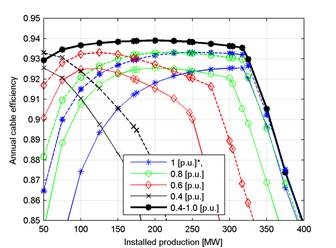This blog (and cartoon!) presents an open innovation to minimize electrical losses in long HVAC export cables connecting offshore wind farms.
Find out more about SINTEF’s expertise on Offshore Wind.
The innovation does not require development of new equipment or large investments, but is a new way of operating the cable that will reduce losses. It can be implemented at existing long AC transmission systems, or to new systems.
The potential net present social economic value of implementing the innovation is EUR 50 – 500 million.
(Find out more details about this innovation below the cartoon.)

The innovation is fully developed by SINTEF Energy Research through work carried out as part of NOWITECH. NOWITECH is co-financed by the Research Council of Norway, industry and research partners.
SINTEF has in agreement with the NOWITECH partners published the method, so it can be developed further.
We will welcome to be part of further commercialization, but most of all like to see the innovation come to practical use contributing to renewable energy development and reduced CO2 emissions.
The innovation
The innovation is a method to minimize electrical losses in long HVAC export cables connecting offshore wind farms.
The current practice is to operate AC transmission cables at nominal voltage. However, the losses in a long AC transmission connecting an offshore wind farm can be minimized by employing a system that controls the voltage depending on the offshore wind farm power output, i.e. the loading of the cable. The voltage can be controlled through the tap-changers of the transformers at each end of the cable, and their optimized operation can be pre-calculated and specified in a look-up table as a function of the wind farm output power, see also schematic above.

The innovation was possible by application of detailed knowledge of AC transmission systems and offshore wind farms. It represents a significant improvement relative to current industry practice and high socio-economic value.
Socio-economic value
It is commonly suggested that if an offshore wind farm is large and far offshore, high-voltage direct current (HVDC) may be the preferred option for connecting the wind farm. This requires however a HVDC converter station offshore and at land, representing quite significant investments. Thus, industry has recently shown interest in applying HVAC transmission for longer distances and higher capacities. E.g., DONG Energy will connect the 1.2 GW Hornsea offshore wind farm with HVAC cables stretching 170 km (Subsea 2016, [1]).
By applying the innovation to such far-offshore wind farms, significant reduction of electric losses can be achieved compared to conventional operation of the HVAC transmission. This improves the economics of far-offshore wind farms and can result in more deployment, which contributes to reaching renewable energy and climate targets.
To illustrate the economic implications, we apply a case assuming a 1,2 GW offshore wind farm connected via four 200 km three-phase HVAC cables each rated 300 MW. Using the same technical specifications as in (Gustavsen & Mo 2016, [2]), we find that applying the innovation, the annual losses in the cables are reduced with one percentage-point compared to the case of operating the cables at nominal voltage as per industry standard, see graph below. This may seem little, but with a wind farm capacity factor of 46 %, a one percent loss reduction corresponds to 48 GWh annually. Assuming an electricity price of EUR 100/MWh, the annual savings are EUR 4.8 million. The investment expenditures for implementing the innovative control is roughly estimated for this case to EUR 12 millions. This is to cover the cost of having tap-changers on the transformers at both ends of the cables and the cost of the control system. Likely, the estimate is on the high side. In comparison, the cost of one 275 MVA transformer is GBP 2.34 million (Elliot et al 2016, [3]). Anyhow, at these conservative assumptions, with 25 years lifetime and 5 % discount rate, the net present value of implementing the innovation becomes EUR 56 million.
The central scenario by the organization Wind Europe specifies 66 GW of offshore wind capacity in Europe by 2030 (EWEA 2015, [4]). Development of offshore wind farms is also expected in China, Japan, South-Korea, USA and others, likely bringing the global offshore wind capacity to about 100 GW by 2030. Out of these, we estimate a share of 20 GW to be connected by long HVAC with cable length of 100 to 200 km.
The potential loss reduction will vary depending on wind farm capacity factor, distance from shore and other factors. As a conservative estimate we assume a net present value of EUR 25 million per installed GW wind capacity, i.e. about half of that we found for the 1.2 GW case above. This gives a total social economic value of EUR 500 million for employing the method to relevant far offshore wind farms by 2030 (20 GW).

References
- Subsea World News (2016) NKT Cables Grabs Hornsea Project One Deal, Accessed 5 April 2016,
- Gustavsen, Bjørn and Olve Mo (2016) Variable Transmission Voltage for Loss Minimization in Long Offshore Wind Farm AC Export Cables, DOI
10.1109/TPWRD.2016.2581879, IEEE Transactions on Power Delivery - Elliott, K.R.W. Bell, S.J. Finney, R. Adapa, C. Brozio, J. Yu and K. Hussain (2016) A comparison of AC and HVDC options for the connection of offshore wind generation in Great Britain,
10.1109/TPWRD.2015.2453233, IEEE Transactions on Power Delivery (Volume: 31, Issue: 2, April 2016) - EWEA (2015) Wind energy scenarios for 2030 (pdf)









Comments
No comments yet. Be the first to comment!